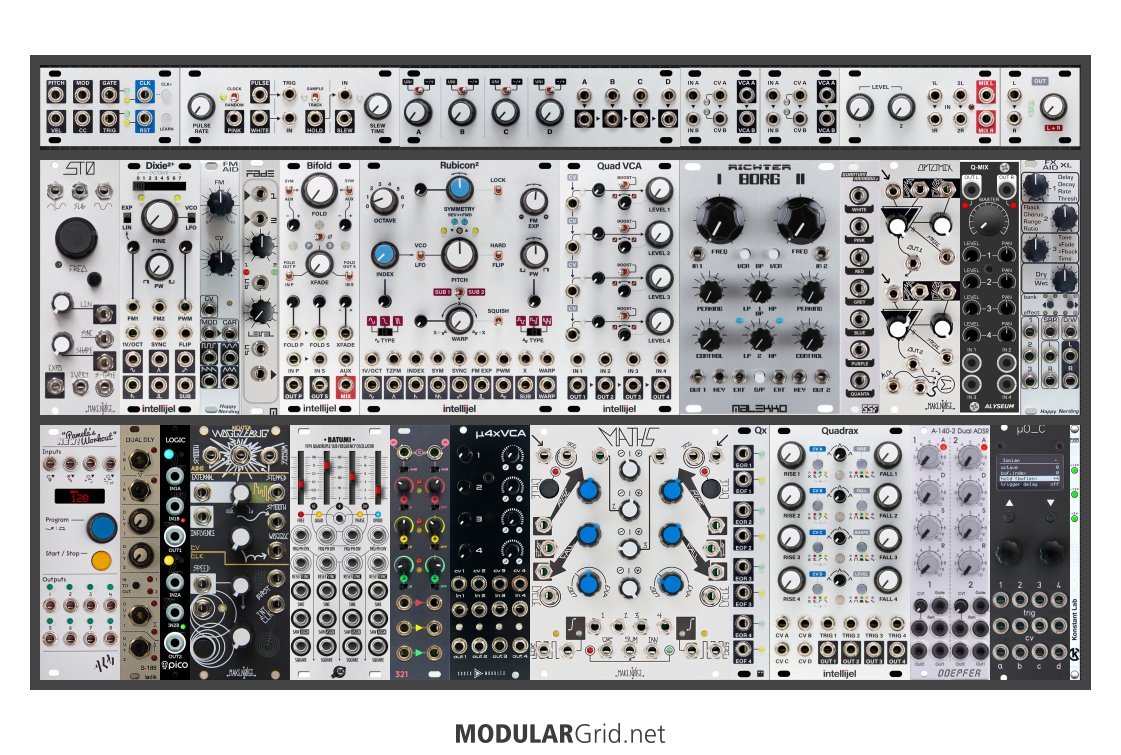OK, that clarified a lot...so, I banged around with this a bit, added some mojo, dropped the older-style Doepfer modules (definite depth issue with one of them, and the single EG was replaced with the dual ADSR because...well, more ADSR) and the mult (use some stackcables or inline mults instead...saves the cab space for function). I also kicked the Contour for some space to drop in a Quadrax/Qx, which ups THAT game x4.

OK...I presumed this was an Intellijel case from your description, so I went with Intellijel tiles. Your MIDI interface is now up there, then a Noise Tools which gives you clocking, S&H, noise, and a slew limiter. The QuadrATT gives you a utility mixer and/or attenuverters. FOUR more VCAs come next for anything you might need some extra VCAs for (like stereo output level control, level control for your FX, etc). After those, you've got a 2-in stereo summing mixer which allows you to parallel the FX Aid below it instead of having to feed through it and using the wet/dry control. After that, your cab's stereo out.
Middle row: STO, Dixie II+...then the REAL missing complex VCO part thanks to Happy Nerding: their FM Aid, which allows thru-zero FM between the two VCOs. Crossfader's after that, then your Bifold. But, continuing with the TZFM thing, I put in Intellijel's take on a complex analog VCO, the Rubicon2. You now have MAD west-coast-style generation going on! Then the Quad VCA lets you impose modulation on four different sources before feeding the Dual Borg. Then, for some fun, I paired the Optomix with an SSF Noise Rainbow 2 so that you now ALSO have a little extra electronic percussion...rather Krautrock-ish style. After this, an Alyseum QMix gives you four channels of level/panning into a stereo sum. But then the OUTPUT fun starts, as you'd use a pair of stackcables to split out your stereo. One pair goes to the Stereo Mixer directly, and the other to the FX Aid XL, then you feed the fully-wet FX Aid's output to the other Stereo Mixer tile's input, and you've got a proper parallel stereo FX return.
Bottom row: Pam's, then a Ladik dual pulse delay allows you to "slip" a couple of clock outputs' timing against a couple of others, letting some neat flam, syncopation, etc activity happen easily. And to make that work in that way (and a few others), I put in a pair of Erica Pico logic gates. Wogglebug, Batumi, then a Frap 321, which is a neat little utility mixer/attenuverter/offset gen-type device that lets you throw different modulation signals at each other to get even more complex modulation signals. A Veils clone is next to give you some modulation-specific VCAs. After that, Maths, then the Qx and Quadrax gives you what the Contour was up to...times four, and then some. And the single ADSR got tossed in favor of the dual ADSR. The O&c follows, then the little sliver on the end is a Konstant Labs PWRcheckr, because it's a good idea to have SOME way to monitor your DC rails' behavior inside the cab.
Result: Majorly beefed-up sound generation, for starters. Having the extra FM capabilities for the two single VCOs will majorly kick them into west-coast turf. And the Rubicon2 complements this arrangement really nicely. And, two voices of noise + LPG percussives, too! Plus, stereo mixing, stereo FX, and parallel FX return ability. Now THAT'S a serious voice row! And the modulation and control...also, massive beef-up. You went from one two-stage to four, then one ADSR to two. Add to that the 321's ability to flip/mangle/alter your modulation, plus the quad VCA...that's ready, too. You could even do basic generative with this, although it's lacking some of the gate pick-offs like comparators, etc. But the Pico Logic actually gives you some very different timing options than just the Pam's alone can. Definitely worth rocking out on now...and complex enough that there's loads of patching options, but not to the point that it's impossible to sort out what's going on. As for the few modules I pulled...well, hey, there's always the next rack, right?

